The Advantages and Applications of Multi-Floor Pre-Engineered Metal Buildings
2024-11-01
The increasing demand for efficient and sustainable building solutions has led to the rise of multi-floor pre-engineered metal buildings (PEMB). These structures are becoming increasingly popular in diverse sectors, including commercial, educational, and industrial facilities. This blog delves into the advantages and applications of multi-floor PEMB, providing insight into why they are a preferred choice for modern construction projects.
Advantages of Multi-Floor PEMB
1. Speed and Efficiency
The prefabrication of building components significantly accelerates the construction process. Multi-floor PEMB can be erected much faster than traditional buildings, which translates to reduced labor costs and quicker occupancy timelines. This rapid construction is particularly advantageous for businesses that require immediate operational space.
2. Durability and Longevity
Steel, the primary material used in PEMB, is known for its strength and durability. Multi-floor PEMB can withstand harsh weather conditions, resist fire, and deter pests, ensuring a longer lifespan compared to conventional materials. This resilience results in lower long-term maintenance costs, making PEMB a financially sound investment.
3. Energy Efficiency
Modern multi-floor PEMB designs often incorporate advanced insulation materials that enhance energy efficiency. By minimizing heat loss in winter and keeping indoor spaces cooler in summer, these buildings can significantly reduce energy consumption and operational costs. Many PEMB also feature sustainable practices, such as the use of reflective roofing to reduce heat absorption.
4. Versatility in Design
Multi-floor PEMB offers remarkable design flexibility, enabling architects to create custom layouts that suit specific needs. From open-concept office spaces to complex educational facilities, the adaptability of PEMB allows for innovative architectural solutions. This versatility extends to aesthetics as well, with various cladding options available to achieve the desired look.
5. Cost-Effectiveness
Due to reduced construction times and lower labor costs, multi-floor PEMB can be more cost-effective than traditional building methods. Additionally, the durability of metal structures leads to fewer repairs and lower maintenance expenses over time, making them an attractive option for budget-conscious organizations.
Applications of Multi-Floor PEMB
1. Commercial Buildings
Multi-floor PEMB is increasingly used for office buildings, retail spaces, and mixed-use developments. The flexibility in design allows for efficient layouts that promote productivity while meeting the needs of diverse tenants. The rapid construction process also aligns well with the fast-paced nature of commercial real estate.
2. Educational Facilities
Schools and universities benefit from multi-floor PEMB by creating versatile environments that can accommodate classrooms, laboratories, and administrative offices. The modular design enables educational institutions to expand or reconfigure spaces as enrollment numbers fluctuate.
3. Healthcare Centers
Hospitals and clinics require buildings that can adapt to changing healthcare needs. Multi-floor PEMB provides the necessary space for patient care facilities, administrative offices, and support services. The durability of metal structures also enhances hygiene and safety, crucial elements in healthcare environments.
4. Industrial Facilities
Warehouses, manufacturing plants, and distribution centers often leverage multi-floor PEMB for their operational efficiency. The expansive floor space allows for the accommodation of machinery and inventory, while the structural integrity of PEMB supports heavy loads.
As industries continue to evolve, the demand for innovative and efficient building solutions is paramount. Multi-floor pre-engineered metal buildings stand out as a practical choice, offering numerous advantages in speed, durability, energy efficiency, and design flexibility. With applications spanning commercial, educational, healthcare, and industrial sectors, PEMB presents a modern approach to meeting the diverse needs of today's construction landscape. Embracing these advancements can lead to enhanced operational efficiency and a sustainable future for businesses and organizations alike.



